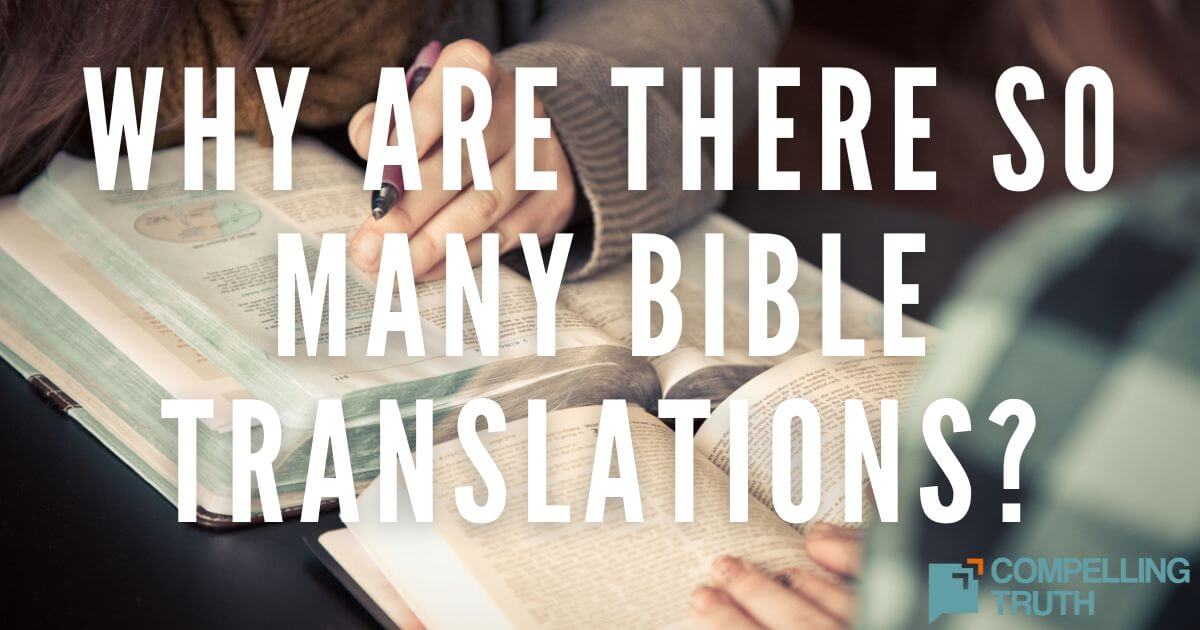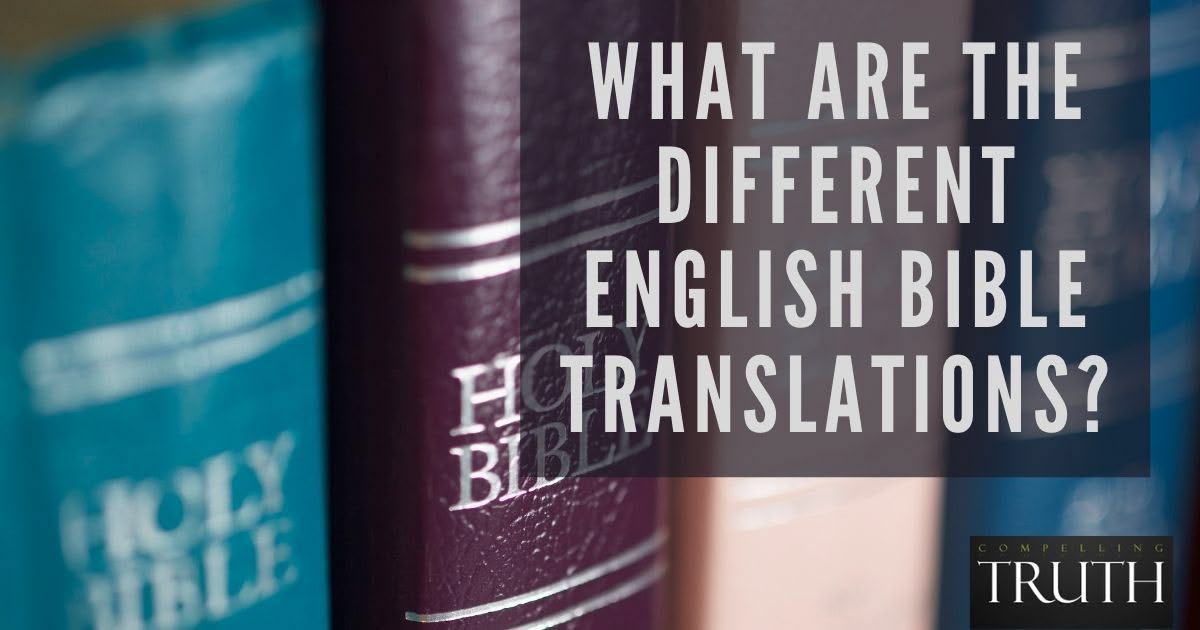There are two primary types of Bible translation methods: dynamic equivalence and formal equivalence. In short, dynamic equivalence is a thought-for-thought translation whereas formal equivalence is a word-for-word translation. Strict word-for-word translation is not always possible, but formal equivalence strives for literal translation true to the original text. Dynamic equivalence strives more for readability and understanding in the target language. As such, dynamic equivalence tends to involve more interpretation from the translators. Usually a translation will fall somewhere on a spectrum between literal and thought-for-thought. The most trustworthy translations are prepared and reviewed by teams of scholars.
Current translations that use more of a formal equivalence or literal translation method include the King James Version (KJV), New King James Version (NKJV), New American Standard Bible (NASB), and English Standard Version (ESV). Translations that use more of a dynamic equivalence, also called "functional equivalence," approach include the New International Version (NIV) and the New Living Translation (NLT). The New English Translation (NET) also uses a dynamic equivalence approach, but it has extensive footnotes, many of which explain the translation choices. There are also paraphrases, best understood as commentaries rather than translations, done by individuals, such as The Message by Eugene Peterson and The Living Bible by Kenneth Taylor.
Technically speaking, the "most accurate" translation would be a literal translation of the text. However, given the realities of language and culture, strict textual accuracy does not always convey the message. Hebrew, Greek, and Aramaic—the languages of the original manuscripts—have different grammatical structures than does English. So some changes will be necessary to make it readable in English. Idioms can also be a struggle. For example, when someone says in English that they "let the cat out of the bag," they mean they have revealed a secret or prematurely shared information that is coming later. They are not referring to a literal feline in a literal sack. Translating that phrase as "let the cat out of the bag" in the target language would be "accurate" to the text. It would also be "accurate" to say "revealed a secret."
On the formal equivalence side, the King James Version (KJV) is the favorite of many. Many common biblical phrases that we use today are from the KJV because it has had such an impact on culture. However, there are just as many people who steer clear of the KJV for their Bible reading and study because they struggle to understand the Old English. English is not the same language it was centuries ago, so it can be a challenge for current English speakers to properly understand the text. That additional hurdle might make using the KJV prohibitive in seeking to know God's Word.
The New American Standard Bible (NASB) is a more literal translation that was popular among Bible scholars for a time. Others found it difficult to read, particularly for those new to the Bible. One of the preferred versions of the text today is the English Standard Version (ESV). It uses a formal equivalence approach. Additionally, there is a more recent (late 2021) formal equivalent translation release called the Legacy Standard Bible (LSB).
The New International Version (NIV) has long been a preferred dynamic equivalent translation, though there has been controversy over the changes made in the 2011 version. The New Living Translation (NLT) is the most dynamic of the current translations. The Christian Standard Bible (CSB) uses an "optimal equivalence" approach, seeking to balance literal translation with thought-for-thought translation.
It is highly recommended to conduct in-depth Bible study from more than one version, including both formal equivalent and dynamic equivalent versions of the Scriptures. Comparing translations can help us more deeply understand the text as we see the different ways to convey the words literally as well as the different understandings of the thoughts implied. We need to recognize when translators are doing interpretive work, as well as recognize when we need to do deeper study to properly understand the literal words in their context.
Strong's Concordance is an excellent tool to combine with the use of your chosen version of the Bible. Study Bibles can be helpful as they provide contextual and cultural notes, as well as translation notes at times. Commentaries can also be helpful.
There are a lot of good Bible translations available today. To try to single one out as the "best" is difficult. The "best" really depends on the intended use and the person doing the reading. For example, the "best" translation to read to a class of a five-year-olds is likely not the "best" translation for the pastor to do an in-depth study to prepare for his sermon, which may not be the "best" for reading aloud in the church service. Generally speaking, those translations that use the formal equivalence method are considered more "accurate" since there is less interpretation involved. It falls on the reader to properly exegete and interpret the text.
Given the broad availability of English translations and study tools, many enjoy consulting several versions of the text. Some prefer one version for general reading and a different version for deeper study. Those who annually read through the Bible might select a different version each year. What matters most is that we are regularly reading and studying God's Word, seeking to know Him as He truly is.
Current translations that use more of a formal equivalence or literal translation method include the King James Version (KJV), New King James Version (NKJV), New American Standard Bible (NASB), and English Standard Version (ESV). Translations that use more of a dynamic equivalence, also called "functional equivalence," approach include the New International Version (NIV) and the New Living Translation (NLT). The New English Translation (NET) also uses a dynamic equivalence approach, but it has extensive footnotes, many of which explain the translation choices. There are also paraphrases, best understood as commentaries rather than translations, done by individuals, such as The Message by Eugene Peterson and The Living Bible by Kenneth Taylor.
Technically speaking, the "most accurate" translation would be a literal translation of the text. However, given the realities of language and culture, strict textual accuracy does not always convey the message. Hebrew, Greek, and Aramaic—the languages of the original manuscripts—have different grammatical structures than does English. So some changes will be necessary to make it readable in English. Idioms can also be a struggle. For example, when someone says in English that they "let the cat out of the bag," they mean they have revealed a secret or prematurely shared information that is coming later. They are not referring to a literal feline in a literal sack. Translating that phrase as "let the cat out of the bag" in the target language would be "accurate" to the text. It would also be "accurate" to say "revealed a secret."
On the formal equivalence side, the King James Version (KJV) is the favorite of many. Many common biblical phrases that we use today are from the KJV because it has had such an impact on culture. However, there are just as many people who steer clear of the KJV for their Bible reading and study because they struggle to understand the Old English. English is not the same language it was centuries ago, so it can be a challenge for current English speakers to properly understand the text. That additional hurdle might make using the KJV prohibitive in seeking to know God's Word.
The New American Standard Bible (NASB) is a more literal translation that was popular among Bible scholars for a time. Others found it difficult to read, particularly for those new to the Bible. One of the preferred versions of the text today is the English Standard Version (ESV). It uses a formal equivalence approach. Additionally, there is a more recent (late 2021) formal equivalent translation release called the Legacy Standard Bible (LSB).
The New International Version (NIV) has long been a preferred dynamic equivalent translation, though there has been controversy over the changes made in the 2011 version. The New Living Translation (NLT) is the most dynamic of the current translations. The Christian Standard Bible (CSB) uses an "optimal equivalence" approach, seeking to balance literal translation with thought-for-thought translation.
It is highly recommended to conduct in-depth Bible study from more than one version, including both formal equivalent and dynamic equivalent versions of the Scriptures. Comparing translations can help us more deeply understand the text as we see the different ways to convey the words literally as well as the different understandings of the thoughts implied. We need to recognize when translators are doing interpretive work, as well as recognize when we need to do deeper study to properly understand the literal words in their context.
Strong's Concordance is an excellent tool to combine with the use of your chosen version of the Bible. Study Bibles can be helpful as they provide contextual and cultural notes, as well as translation notes at times. Commentaries can also be helpful.
There are a lot of good Bible translations available today. To try to single one out as the "best" is difficult. The "best" really depends on the intended use and the person doing the reading. For example, the "best" translation to read to a class of a five-year-olds is likely not the "best" translation for the pastor to do an in-depth study to prepare for his sermon, which may not be the "best" for reading aloud in the church service. Generally speaking, those translations that use the formal equivalence method are considered more "accurate" since there is less interpretation involved. It falls on the reader to properly exegete and interpret the text.
Given the broad availability of English translations and study tools, many enjoy consulting several versions of the text. Some prefer one version for general reading and a different version for deeper study. Those who annually read through the Bible might select a different version each year. What matters most is that we are regularly reading and studying God's Word, seeking to know Him as He truly is.



